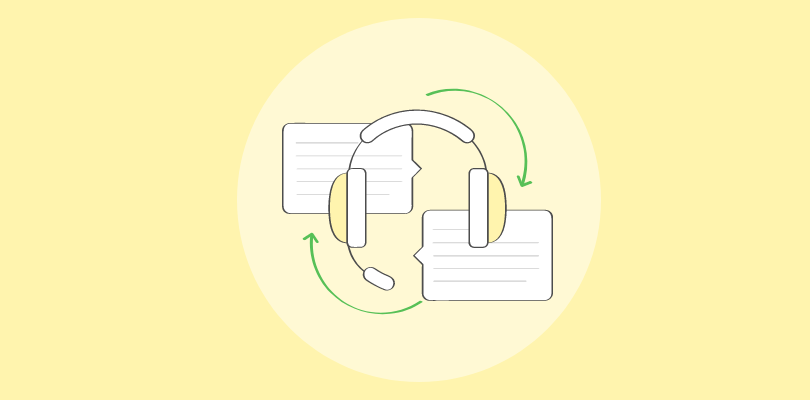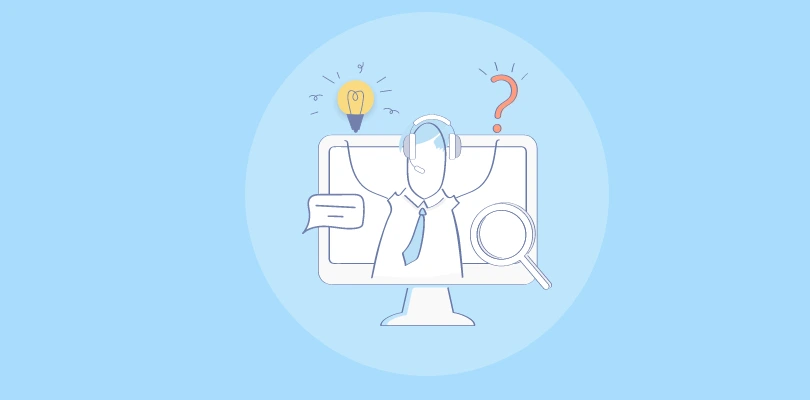
“Printer not working,” “Forgot my password,” “Can’t connect to the server” — these are just a few of the common issues that an IT help desk addresses daily.
From resolving immediate technical problems to offering guidance on software and hardware usage, an IT help desk is the backbone of effective IT support. It is an essential business function that ensures minimal downtime and maximum productivity.
This blog explores the key benefits of an IT help desk, best practices for maximizing its efficiency, and a detailed look at how it functions within an organization.
What Is an IT Help Desk?
An IT help desk is a support service designed to provide technical assistance to users. It acts as the first point of contact for resolving IT issues, such as troubleshooting hardware and software problems, managing user accounts, and answering technical questions.
The help desk for IT can be internal, supporting employees within an organization, or external, assisting customers with a company’s products or services. They improve productivity by quickly addressing technical issues, ensuring systems run smoothly, and enhancing overall user experience.
What Is IT Help Desk Software?
IT help desk software is a tool designed to streamline the process of providing technical support within an organization. It allows IT teams to manage, track, and resolve user issues efficiently through features such as ticketing systems, automated workflows, and knowledge bases.
An IT help desk system provides a centralized platform for addressing IT-related problems, helping to organize and prioritize support requests, ensuring timely resolution, and enhancing overall productivity and user satisfaction.
Common issues handled by IT support agents include troubleshooting connectivity problems, resolving software errors, managing password resets, and addressing hardware malfunctions.
Read More: 15 Best IT Ticketing System Software to Manage IT Support Like a Pro in 2024
How Does IT Help Desk Software Work?
Multiple steps are involved in resolving an IT issue from ticket creation to closure. Here is an explanation of how IT help desk software works, explained in steps:
Step 1: Ticket Creation:
Users submit issues through various channels like email, web forms, or live chat. These issues are automatically converted into tickets within the IT help desk software.
Step 2: Ticket Assignment:
The software categorizes and prioritizes tickets based on predefined criteria and assigns them to the appropriate IT support agent or team.
Step 3: Issue Diagnosis:
Support agents analyze the ticket, diagnose the problem, and determine the necessary steps to resolve it. They may use integrated knowledge bases or diagnostic tools within the software.
Step 4: Resolution and Communication:
Agents resolve the issue and update the ticket with the solution. They communicate with the user, providing updates and confirming the resolution, ensuring the user is kept informed throughout the process.
Step 5: Ticket Closure:
The ticket is closed once the issue is resolved and the user is satisfied. The solution and steps taken are documented for future reference.

Step 6: Reporting and Analytics:
The software generates reports and analytics on ticket trends, agent performance, and common issues. This data helps in identifying areas for improvement and making informed decisions.

What Are the Benefits of IT Help Desk Software?
1. Improved Efficiency
IT help desk software centralizes all support requests, making managing and tracking issues easier. Automated workflows and ticketing systems ensure that requests are routed to the right agents quickly, reducing response times.
This streamlining of processes allows IT teams to handle a higher volume of requests efficiently, minimizing downtime and enhancing overall productivity.
2. Enhanced User Satisfaction
IT help desk software significantly improves user satisfaction by providing timely and effective solutions to technical problems.
Features like self-service portals and knowledge bases empower users to resolve minor issues independently, leading to quicker resolutions and a better user experience. Personalized support and consistent communication further contribute to higher satisfaction levels.
Read More: What Is Customer Satisfaction? Benefits, CSAT Measurement & Tools
3. Better Resource Management
IT help desk software offers detailed reporting and analytics, enabling organizations to monitor the performance of their IT support teams.
By analyzing these metrics, businesses can identify bottlenecks, allocate resources more effectively, and make data-driven decisions to improve service delivery. This leads to more efficient use of time and personnel.
4. Increased Accountability
With IT help desk software, all support requests are logged and tracked, ensuring accountability at every step.
Agents can monitor ticket status, and management can oversee the resolution process. This transparency helps identify recurring issues, assess support staff performance, and promptly address all problems.
5. Improved Scalability
IT help desk software is scalable, accommodating an organization’s growing needs. As businesses expand, the software can handle increasing support requests without compromising efficiency or performance.
This scalability ensures that the IT support infrastructure can grow alongside the organization, providing consistent and reliable support.
Read More: How to Reduce Support Ticket Volume in 15 Sure-Fire Ways
IT Help Desk Best Practices
Do you want to maximize your IT support efforts? Follow these IT help desk best practices for maximum results.
1. Implement a Robust Ticketing System
Utilize a centralized ticketing system to track, prioritize, and manage all support requests.
This ensures that every issue is logged and assigned to the appropriate team member for resolution. A robust ticketing system allows for better organization, helps in identifying recurring issues, and provides a clear record of all interactions, which is essential for accountability and continuous improvement.
Read More: Ticketing System Guide: Definition, Features & Benefits Explained
2. Automate Routine Tasks
Automate repetitive tasks such as password resets, software updates, basic troubleshooting, and routine maintenance.
Automation can significantly reduce the workload on your IT staff, allowing them to focus on more complex and critical issues. Integrating automation tools with your ticketing system ensures that common problems are resolved quickly and efficiently, improving overall productivity and user satisfaction.
Read More: 10 Service Desk Automation Ideas that Boost Performance and Quality
3. Provide Self-Service Options
Develop a comprehensive knowledge base and frequently asked questions (FAQs) section to empower users to resolve common issues on their own.
Self-service portals can include step-by-step guides, video tutorials, and troubleshooting tips. By enabling users to find answers independently, you reduce the volume of incoming tickets and allow your IT team to concentrate on more significant problems, thus speeding up the resolution process.
4. Offer Continuous Training to IT Support Staff
Regularly train your support staff on new technologies, tools, and best practices.
Continuous training and learning ensures that your team remains knowledgeable and proficient in handling various technical issues.
Training sessions can include workshops, certifications, and access to online courses. Keeping your team updated on the latest trends and tools enhances their skills and boosts their confidence in managing complex situations.
Read More: The Ultimate Guide to Customer Service Training & Onboarding
5. Set Realistic SLAs (Service Level Agreements)
Define and communicate realistic SLAs for different types of support requests.
Setting clear expectations for response and resolution times helps manage user expectations and ensures that your IT team is working towards achievable goals.
Regularly review and adjust SLAs based on performance data and user feedback to ensure they remain relevant and attainable.
6. Monitor and Analyze Performance
Use analytics and reporting tools to monitor key performance indicators (KPIs) such as ticket resolution times, customer satisfaction scores, and the number of tickets handled per agent.
Regular analysis of these metrics helps identify bottlenecks, inefficiencies, and areas for improvement. Implementing changes based on data-driven insights can enhance the effectiveness of your help desk operations and improve overall service quality.
What Is the Difference Between IT Help Desk and IT Service Desk?
The terms “IT help desk” and “IT service desk” are often used interchangeably, but they have distinct functions and scopes within an organization’s IT support structure:
IT Help Desk:
- Primary Focus: The IT help desk primarily resolves immediate technical issues and provides support for IT-related problems.
- Scope: It handles incident management, troubleshooting, and basic user support such as password resets, software installations, and hardware issues.
- Nature of Support: The help desk is typically reactive, addressing problems as they arise.
IT Service Desk:
- Primary Focus: The IT service desk has a broader scope, focusing not only on resolving incidents but also on delivering a wide range of IT services and managing the overall IT infrastructure.
- Scope: It encompasses service management functions such as service request management, change management, and problem management, following ITIL (Information Technology Infrastructure Library) best practices.
- Nature of Support: The service desk is both reactive and proactive, aiming to improve IT processes and services continually.
Optimize Your IT Help Desk Today
An IT help desk is a critical component of any modern organization, providing essential support for various technical issues.
By streamlining the resolution of IT problems, it enhances productivity, reduces downtime, and improves user satisfaction. Implementing best practices such as leveraging a robust ticketing system, automating routine tasks, and continuous training can maximize the efficiency of your IT help desk.
Want to see robust IT help desk software in action? Look no further. ProProfs Help Desk lets you understand the user intent, save time with AI-generated responses, and improve support quality with reports and surveys. Ready to delight your IT users?
FREE. All Features. FOREVER!
Try our Forever FREE account with all premium features!




